ECON1020: Finland Country Report - Macroeconomic Performance Analysis
VerifiedAdded on 2022/08/25
|13
|3097
|23
Report
AI Summary
This country report for ECON1020 provides a comprehensive analysis of Finland's macroeconomic performance from 2011 to 2018. It examines key indicators such as GDP per capita, inflation rates, and unemployment rates, highlighting trends and fluctuations during the period. The report benchmarks Finland's economic performance against Denmark, focusing on factors like FDI attractiveness, social services, and labor market resilience. It also delves into the environmental challenges associated with Finland's economic development, including deforestation, pollution, and air quality issues. Based on the findings, the report offers recommendations for sustainable economic growth and addresses the limitations of these recommendations.
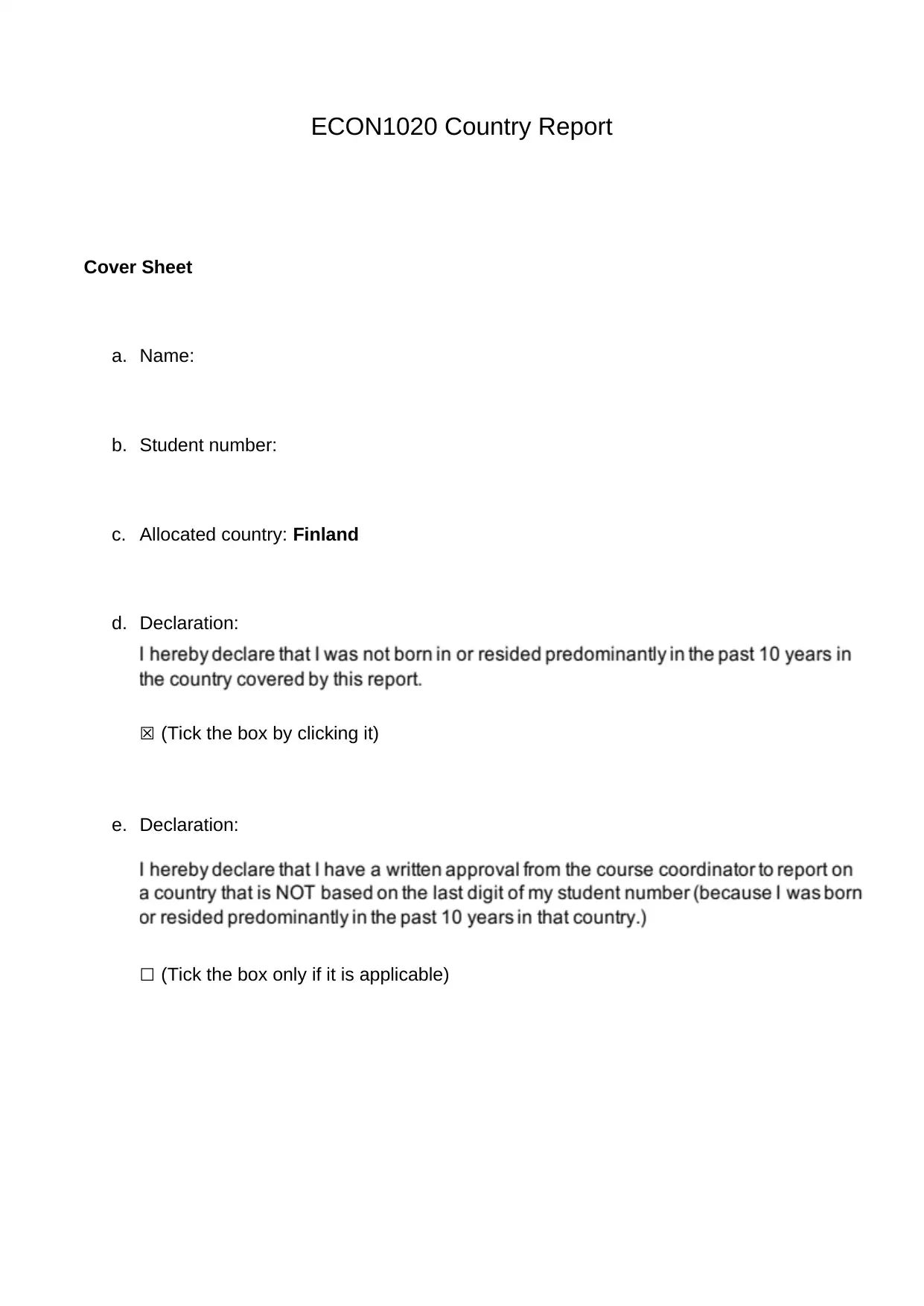
ECON1020 Country Report
Cover Sheet
a. Name:
b. Student number:
c. Allocated country: Finland
d. Declaration:
☒ (Tick the box by clicking it)
e. Declaration:
☐ (Tick the box only if it is applicable)
Cover Sheet
a. Name:
b. Student number:
c. Allocated country: Finland
d. Declaration:
☒ (Tick the box by clicking it)
e. Declaration:
☐ (Tick the box only if it is applicable)
Paraphrase This Document
Need a fresh take? Get an instant paraphrase of this document with our AI Paraphraser
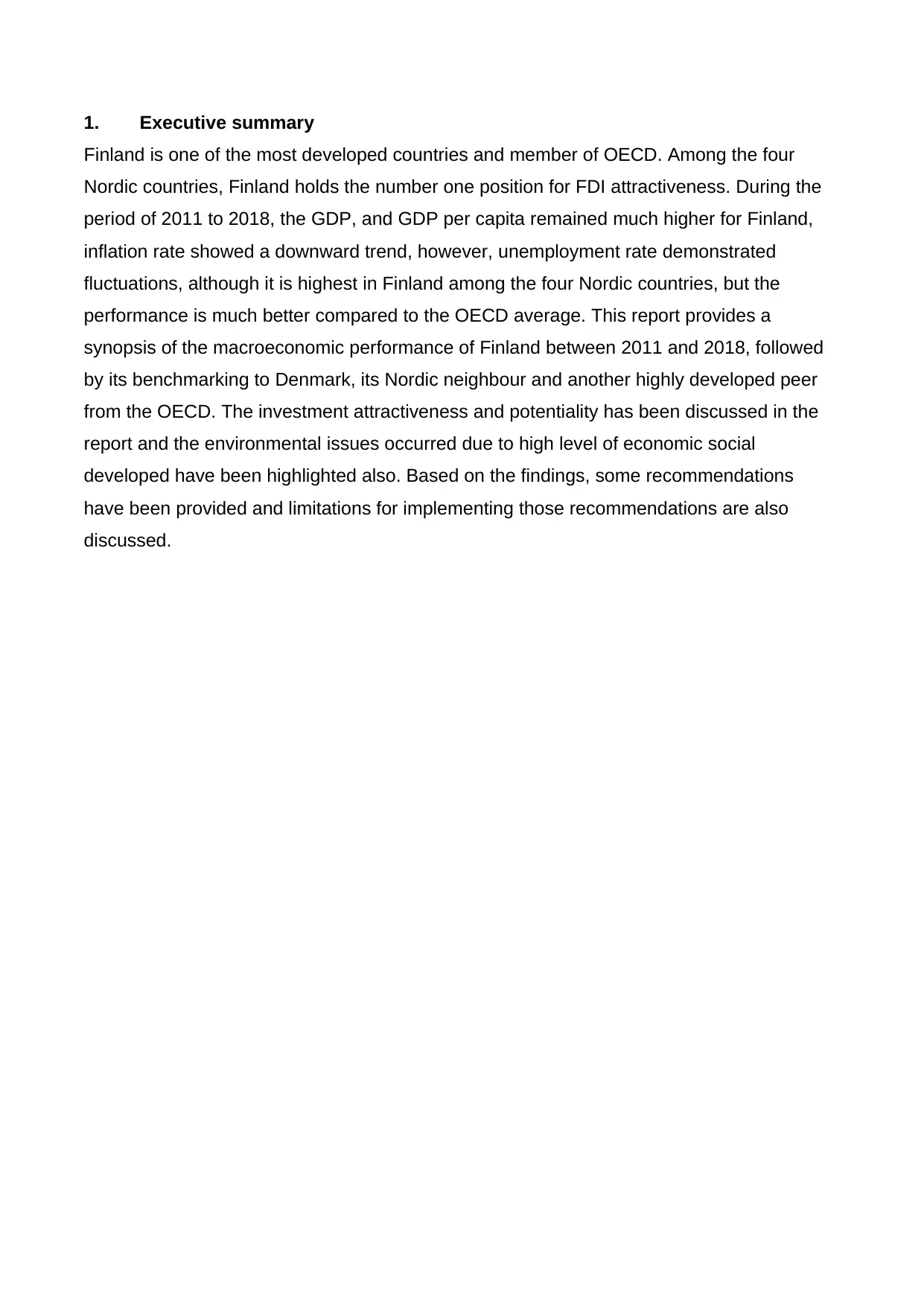
1. Executive summary
Finland is one of the most developed countries and member of OECD. Among the four
Nordic countries, Finland holds the number one position for FDI attractiveness. During the
period of 2011 to 2018, the GDP, and GDP per capita remained much higher for Finland,
inflation rate showed a downward trend, however, unemployment rate demonstrated
fluctuations, although it is highest in Finland among the four Nordic countries, but the
performance is much better compared to the OECD average. This report provides a
synopsis of the macroeconomic performance of Finland between 2011 and 2018, followed
by its benchmarking to Denmark, its Nordic neighbour and another highly developed peer
from the OECD. The investment attractiveness and potentiality has been discussed in the
report and the environmental issues occurred due to high level of economic social
developed have been highlighted also. Based on the findings, some recommendations
have been provided and limitations for implementing those recommendations are also
discussed.
Finland is one of the most developed countries and member of OECD. Among the four
Nordic countries, Finland holds the number one position for FDI attractiveness. During the
period of 2011 to 2018, the GDP, and GDP per capita remained much higher for Finland,
inflation rate showed a downward trend, however, unemployment rate demonstrated
fluctuations, although it is highest in Finland among the four Nordic countries, but the
performance is much better compared to the OECD average. This report provides a
synopsis of the macroeconomic performance of Finland between 2011 and 2018, followed
by its benchmarking to Denmark, its Nordic neighbour and another highly developed peer
from the OECD. The investment attractiveness and potentiality has been discussed in the
report and the environmental issues occurred due to high level of economic social
developed have been highlighted also. Based on the findings, some recommendations
have been provided and limitations for implementing those recommendations are also
discussed.
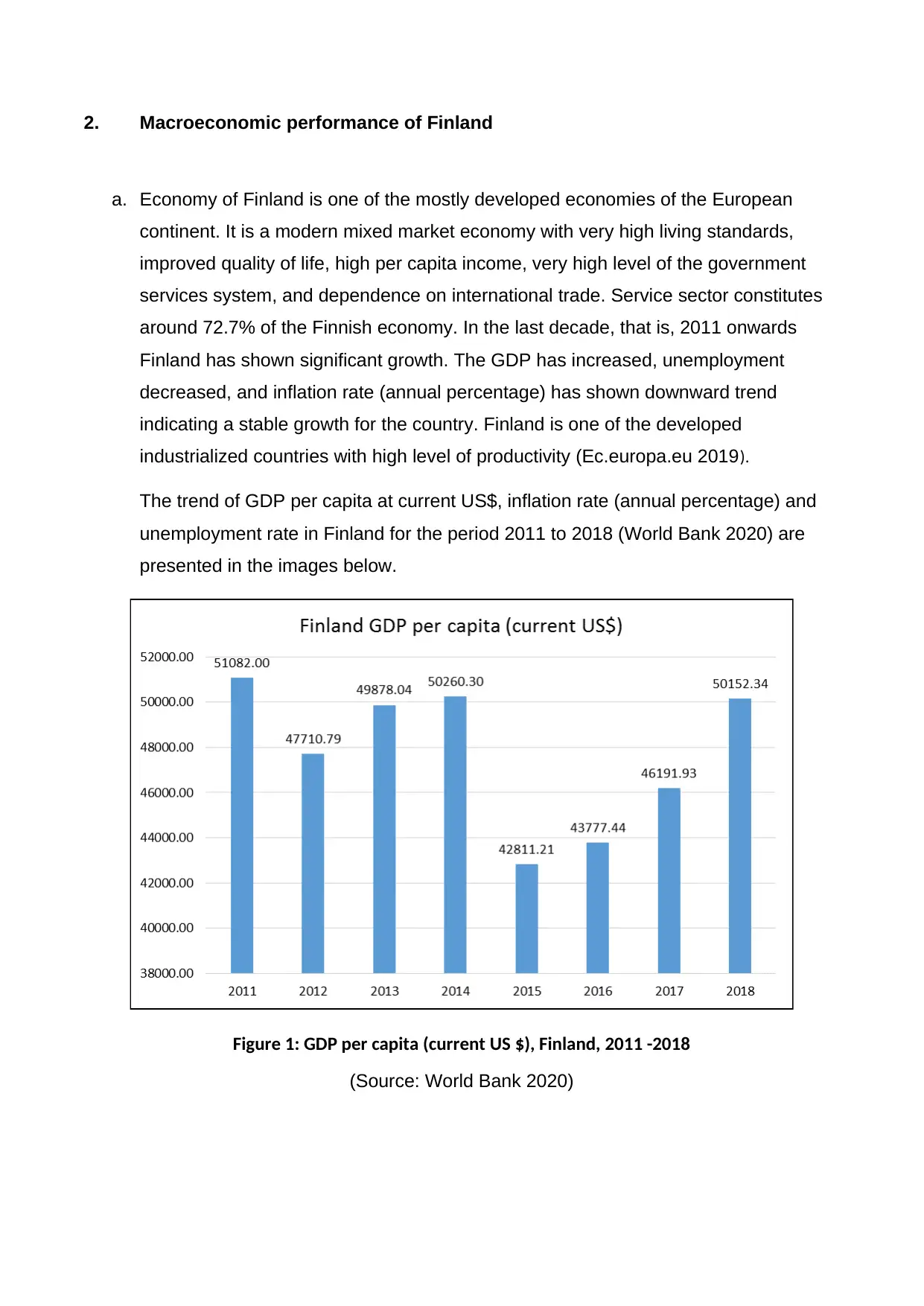
2. Macroeconomic performance of Finland
a. Economy of Finland is one of the mostly developed economies of the European
continent. It is a modern mixed market economy with very high living standards,
improved quality of life, high per capita income, very high level of the government
services system, and dependence on international trade. Service sector constitutes
around 72.7% of the Finnish economy. In the last decade, that is, 2011 onwards
Finland has shown significant growth. The GDP has increased, unemployment
decreased, and inflation rate (annual percentage) has shown downward trend
indicating a stable growth for the country. Finland is one of the developed
industrialized countries with high level of productivity (Ec.europa.eu 2019).
The trend of GDP per capita at current US$, inflation rate (annual percentage) and
unemployment rate in Finland for the period 2011 to 2018 (World Bank 2020) are
presented in the images below.
Figure 1: GDP per capita (current US $), Finland, 2011 -2018
(Source: World Bank 2020)
a. Economy of Finland is one of the mostly developed economies of the European
continent. It is a modern mixed market economy with very high living standards,
improved quality of life, high per capita income, very high level of the government
services system, and dependence on international trade. Service sector constitutes
around 72.7% of the Finnish economy. In the last decade, that is, 2011 onwards
Finland has shown significant growth. The GDP has increased, unemployment
decreased, and inflation rate (annual percentage) has shown downward trend
indicating a stable growth for the country. Finland is one of the developed
industrialized countries with high level of productivity (Ec.europa.eu 2019).
The trend of GDP per capita at current US$, inflation rate (annual percentage) and
unemployment rate in Finland for the period 2011 to 2018 (World Bank 2020) are
presented in the images below.
Figure 1: GDP per capita (current US $), Finland, 2011 -2018
(Source: World Bank 2020)
⊘ This is a preview!⊘
Do you want full access?
Subscribe today to unlock all pages.

Trusted by 1+ million students worldwide
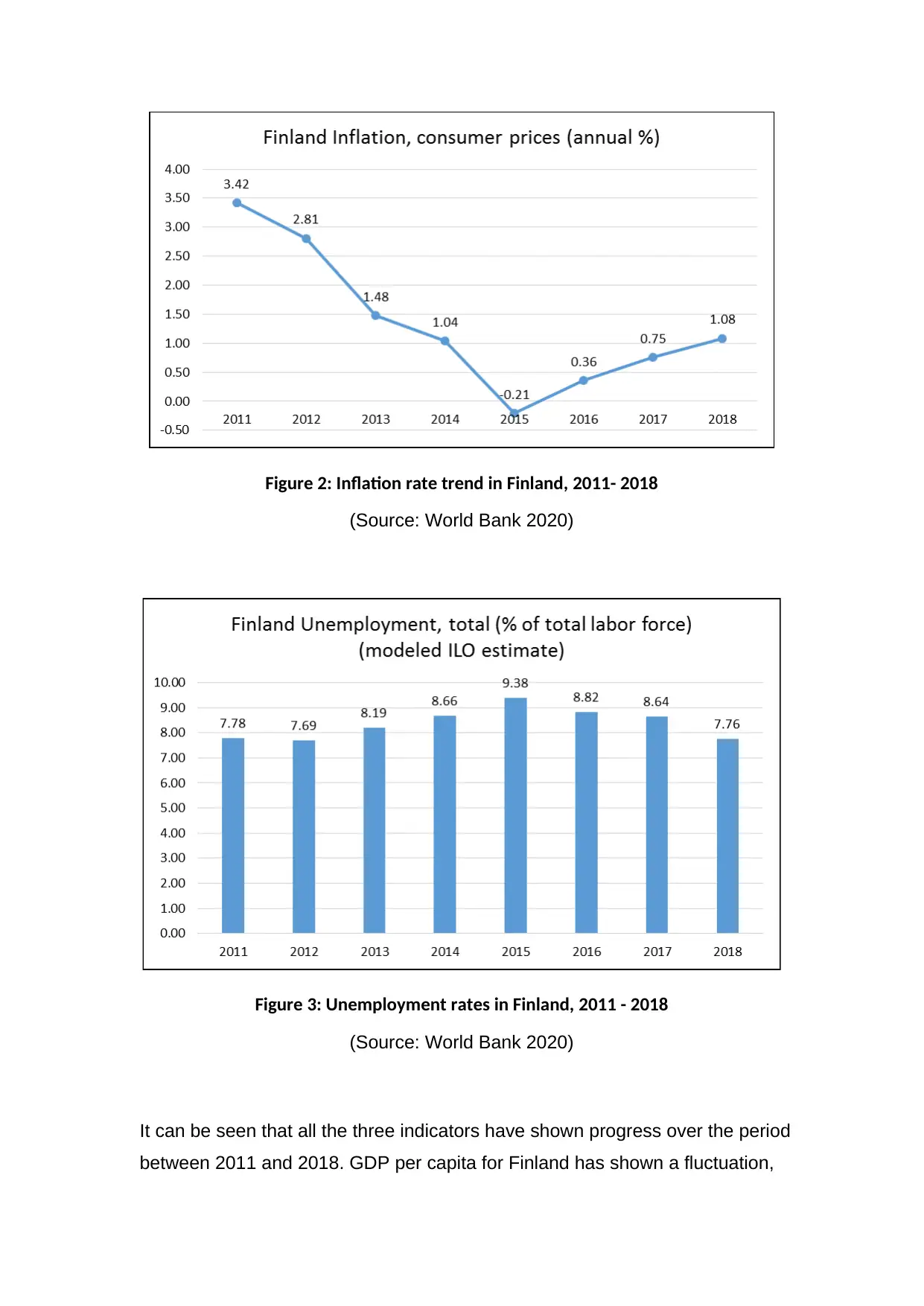
Figure 2: Inflation rate trend in Finland, 2011- 2018
(Source: World Bank 2020)
Figure 3: Unemployment rates in Finland, 2011 - 2018
(Source: World Bank 2020)
It can be seen that all the three indicators have shown progress over the period
between 2011 and 2018. GDP per capita for Finland has shown a fluctuation,
(Source: World Bank 2020)
Figure 3: Unemployment rates in Finland, 2011 - 2018
(Source: World Bank 2020)
It can be seen that all the three indicators have shown progress over the period
between 2011 and 2018. GDP per capita for Finland has shown a fluctuation,
Paraphrase This Document
Need a fresh take? Get an instant paraphrase of this document with our AI Paraphraser
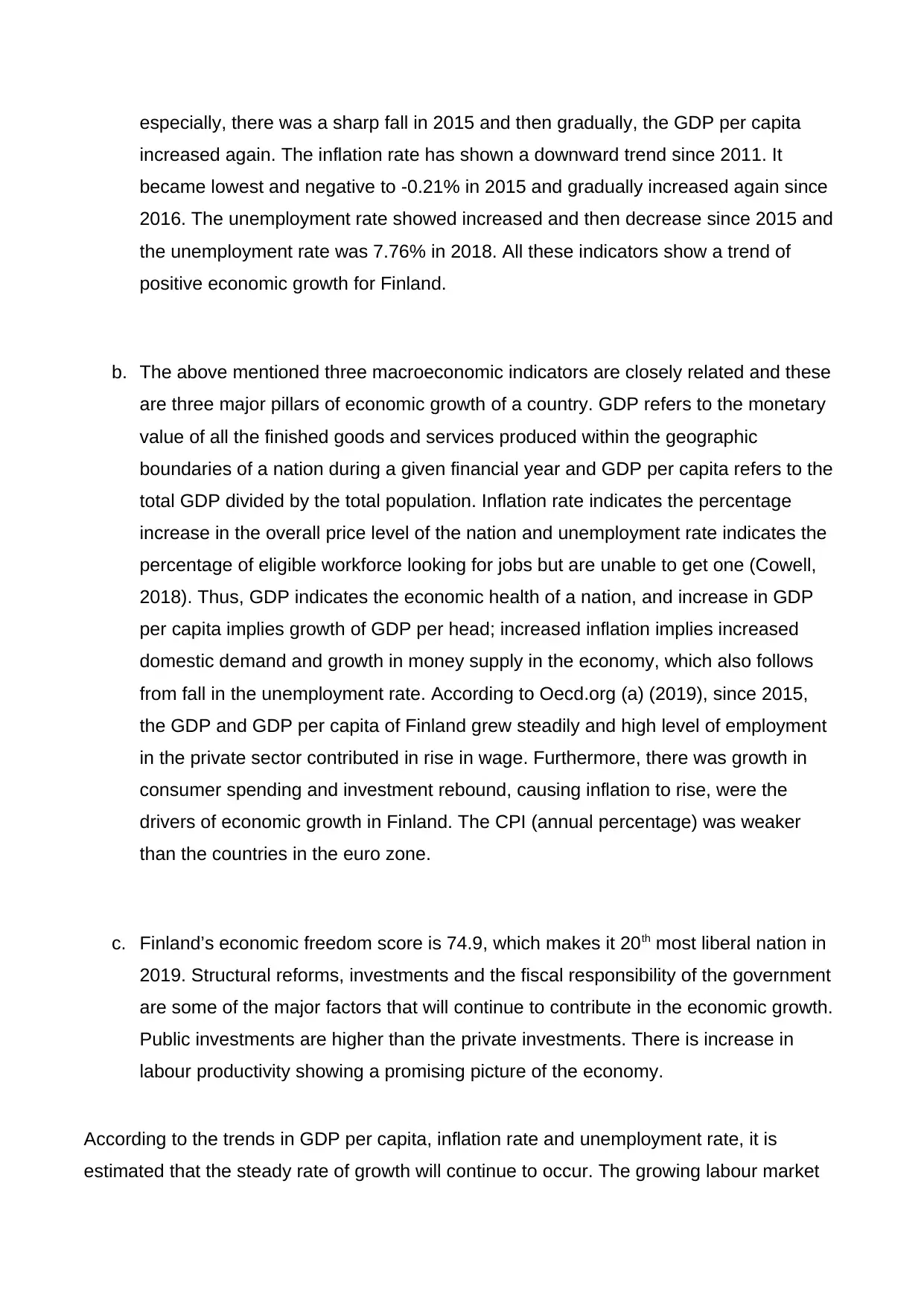
especially, there was a sharp fall in 2015 and then gradually, the GDP per capita
increased again. The inflation rate has shown a downward trend since 2011. It
became lowest and negative to -0.21% in 2015 and gradually increased again since
2016. The unemployment rate showed increased and then decrease since 2015 and
the unemployment rate was 7.76% in 2018. All these indicators show a trend of
positive economic growth for Finland.
b. The above mentioned three macroeconomic indicators are closely related and these
are three major pillars of economic growth of a country. GDP refers to the monetary
value of all the finished goods and services produced within the geographic
boundaries of a nation during a given financial year and GDP per capita refers to the
total GDP divided by the total population. Inflation rate indicates the percentage
increase in the overall price level of the nation and unemployment rate indicates the
percentage of eligible workforce looking for jobs but are unable to get one (Cowell,
2018). Thus, GDP indicates the economic health of a nation, and increase in GDP
per capita implies growth of GDP per head; increased inflation implies increased
domestic demand and growth in money supply in the economy, which also follows
from fall in the unemployment rate. According to Oecd.org (a) (2019), since 2015,
the GDP and GDP per capita of Finland grew steadily and high level of employment
in the private sector contributed in rise in wage. Furthermore, there was growth in
consumer spending and investment rebound, causing inflation to rise, were the
drivers of economic growth in Finland. The CPI (annual percentage) was weaker
than the countries in the euro zone.
c. Finland’s economic freedom score is 74.9, which makes it 20th most liberal nation in
2019. Structural reforms, investments and the fiscal responsibility of the government
are some of the major factors that will continue to contribute in the economic growth.
Public investments are higher than the private investments. There is increase in
labour productivity showing a promising picture of the economy.
According to the trends in GDP per capita, inflation rate and unemployment rate, it is
estimated that the steady rate of growth will continue to occur. The growing labour market
increased again. The inflation rate has shown a downward trend since 2011. It
became lowest and negative to -0.21% in 2015 and gradually increased again since
2016. The unemployment rate showed increased and then decrease since 2015 and
the unemployment rate was 7.76% in 2018. All these indicators show a trend of
positive economic growth for Finland.
b. The above mentioned three macroeconomic indicators are closely related and these
are three major pillars of economic growth of a country. GDP refers to the monetary
value of all the finished goods and services produced within the geographic
boundaries of a nation during a given financial year and GDP per capita refers to the
total GDP divided by the total population. Inflation rate indicates the percentage
increase in the overall price level of the nation and unemployment rate indicates the
percentage of eligible workforce looking for jobs but are unable to get one (Cowell,
2018). Thus, GDP indicates the economic health of a nation, and increase in GDP
per capita implies growth of GDP per head; increased inflation implies increased
domestic demand and growth in money supply in the economy, which also follows
from fall in the unemployment rate. According to Oecd.org (a) (2019), since 2015,
the GDP and GDP per capita of Finland grew steadily and high level of employment
in the private sector contributed in rise in wage. Furthermore, there was growth in
consumer spending and investment rebound, causing inflation to rise, were the
drivers of economic growth in Finland. The CPI (annual percentage) was weaker
than the countries in the euro zone.
c. Finland’s economic freedom score is 74.9, which makes it 20th most liberal nation in
2019. Structural reforms, investments and the fiscal responsibility of the government
are some of the major factors that will continue to contribute in the economic growth.
Public investments are higher than the private investments. There is increase in
labour productivity showing a promising picture of the economy.
According to the trends in GDP per capita, inflation rate and unemployment rate, it is
estimated that the steady rate of growth will continue to occur. The growing labour market
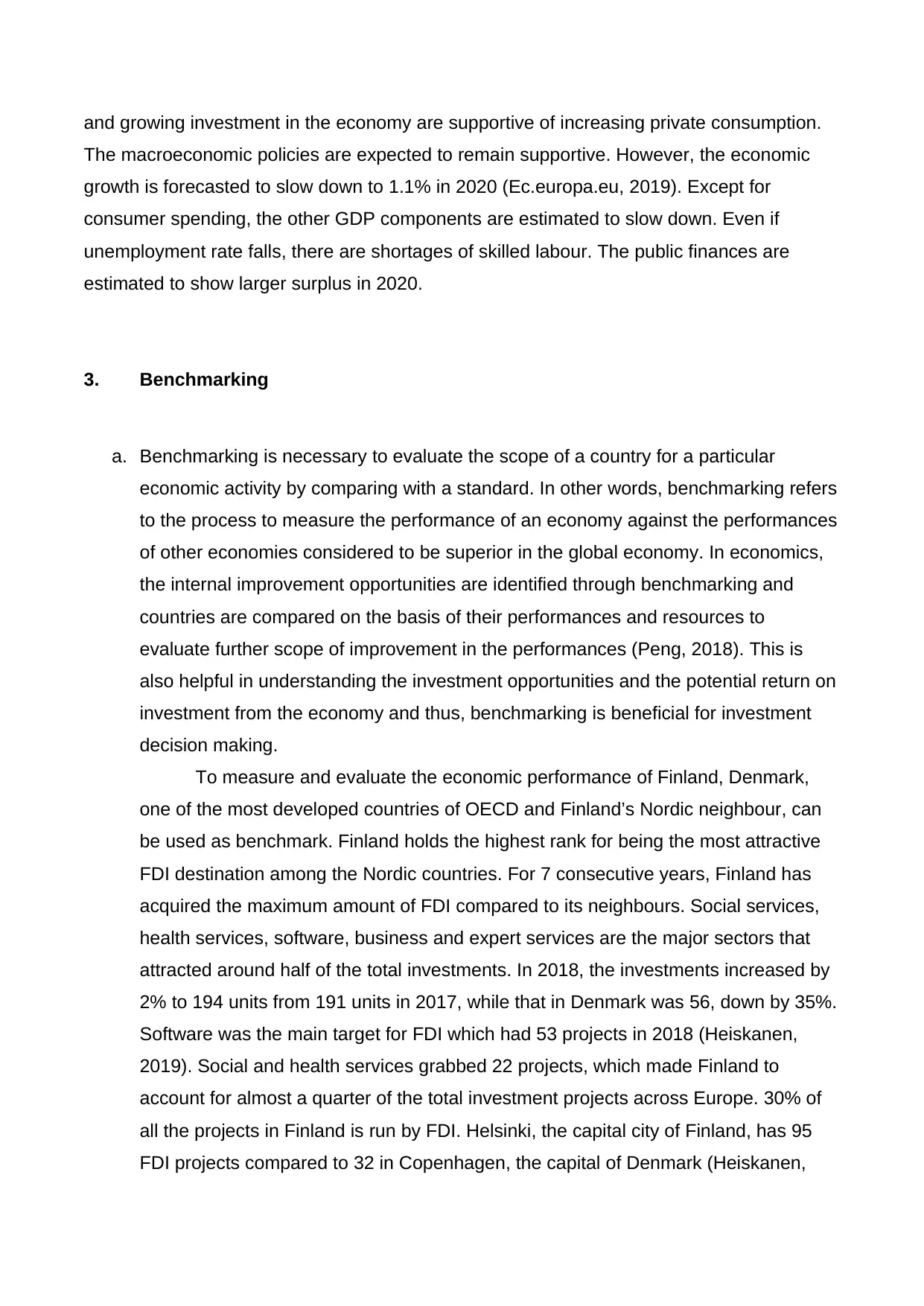
and growing investment in the economy are supportive of increasing private consumption.
The macroeconomic policies are expected to remain supportive. However, the economic
growth is forecasted to slow down to 1.1% in 2020 (Ec.europa.eu, 2019). Except for
consumer spending, the other GDP components are estimated to slow down. Even if
unemployment rate falls, there are shortages of skilled labour. The public finances are
estimated to show larger surplus in 2020.
3. Benchmarking
a. Benchmarking is necessary to evaluate the scope of a country for a particular
economic activity by comparing with a standard. In other words, benchmarking refers
to the process to measure the performance of an economy against the performances
of other economies considered to be superior in the global economy. In economics,
the internal improvement opportunities are identified through benchmarking and
countries are compared on the basis of their performances and resources to
evaluate further scope of improvement in the performances (Peng, 2018). This is
also helpful in understanding the investment opportunities and the potential return on
investment from the economy and thus, benchmarking is beneficial for investment
decision making.
To measure and evaluate the economic performance of Finland, Denmark,
one of the most developed countries of OECD and Finland’s Nordic neighbour, can
be used as benchmark. Finland holds the highest rank for being the most attractive
FDI destination among the Nordic countries. For 7 consecutive years, Finland has
acquired the maximum amount of FDI compared to its neighbours. Social services,
health services, software, business and expert services are the major sectors that
attracted around half of the total investments. In 2018, the investments increased by
2% to 194 units from 191 units in 2017, while that in Denmark was 56, down by 35%.
Software was the main target for FDI which had 53 projects in 2018 (Heiskanen,
2019). Social and health services grabbed 22 projects, which made Finland to
account for almost a quarter of the total investment projects across Europe. 30% of
all the projects in Finland is run by FDI. Helsinki, the capital city of Finland, has 95
FDI projects compared to 32 in Copenhagen, the capital of Denmark (Heiskanen,
The macroeconomic policies are expected to remain supportive. However, the economic
growth is forecasted to slow down to 1.1% in 2020 (Ec.europa.eu, 2019). Except for
consumer spending, the other GDP components are estimated to slow down. Even if
unemployment rate falls, there are shortages of skilled labour. The public finances are
estimated to show larger surplus in 2020.
3. Benchmarking
a. Benchmarking is necessary to evaluate the scope of a country for a particular
economic activity by comparing with a standard. In other words, benchmarking refers
to the process to measure the performance of an economy against the performances
of other economies considered to be superior in the global economy. In economics,
the internal improvement opportunities are identified through benchmarking and
countries are compared on the basis of their performances and resources to
evaluate further scope of improvement in the performances (Peng, 2018). This is
also helpful in understanding the investment opportunities and the potential return on
investment from the economy and thus, benchmarking is beneficial for investment
decision making.
To measure and evaluate the economic performance of Finland, Denmark,
one of the most developed countries of OECD and Finland’s Nordic neighbour, can
be used as benchmark. Finland holds the highest rank for being the most attractive
FDI destination among the Nordic countries. For 7 consecutive years, Finland has
acquired the maximum amount of FDI compared to its neighbours. Social services,
health services, software, business and expert services are the major sectors that
attracted around half of the total investments. In 2018, the investments increased by
2% to 194 units from 191 units in 2017, while that in Denmark was 56, down by 35%.
Software was the main target for FDI which had 53 projects in 2018 (Heiskanen,
2019). Social and health services grabbed 22 projects, which made Finland to
account for almost a quarter of the total investment projects across Europe. 30% of
all the projects in Finland is run by FDI. Helsinki, the capital city of Finland, has 95
FDI projects compared to 32 in Copenhagen, the capital of Denmark (Heiskanen,
⊘ This is a preview!⊘
Do you want full access?
Subscribe today to unlock all pages.

Trusted by 1+ million students worldwide
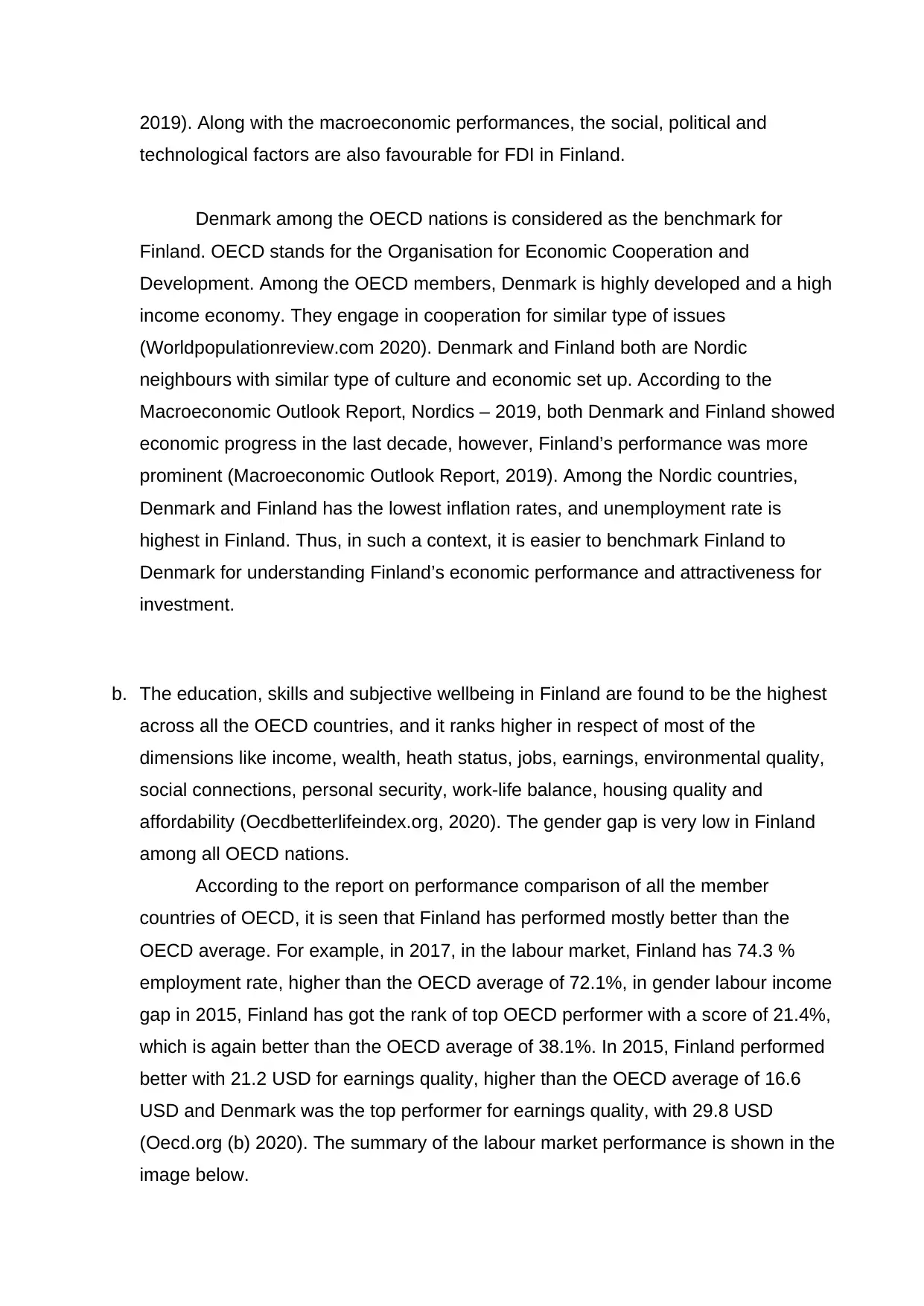
2019). Along with the macroeconomic performances, the social, political and
technological factors are also favourable for FDI in Finland.
Denmark among the OECD nations is considered as the benchmark for
Finland. OECD stands for the Organisation for Economic Cooperation and
Development. Among the OECD members, Denmark is highly developed and a high
income economy. They engage in cooperation for similar type of issues
(Worldpopulationreview.com 2020). Denmark and Finland both are Nordic
neighbours with similar type of culture and economic set up. According to the
Macroeconomic Outlook Report, Nordics – 2019, both Denmark and Finland showed
economic progress in the last decade, however, Finland’s performance was more
prominent (Macroeconomic Outlook Report, 2019). Among the Nordic countries,
Denmark and Finland has the lowest inflation rates, and unemployment rate is
highest in Finland. Thus, in such a context, it is easier to benchmark Finland to
Denmark for understanding Finland’s economic performance and attractiveness for
investment.
b. The education, skills and subjective wellbeing in Finland are found to be the highest
across all the OECD countries, and it ranks higher in respect of most of the
dimensions like income, wealth, heath status, jobs, earnings, environmental quality,
social connections, personal security, work-life balance, housing quality and
affordability (Oecdbetterlifeindex.org, 2020). The gender gap is very low in Finland
among all OECD nations.
According to the report on performance comparison of all the member
countries of OECD, it is seen that Finland has performed mostly better than the
OECD average. For example, in 2017, in the labour market, Finland has 74.3 %
employment rate, higher than the OECD average of 72.1%, in gender labour income
gap in 2015, Finland has got the rank of top OECD performer with a score of 21.4%,
which is again better than the OECD average of 38.1%. In 2015, Finland performed
better with 21.2 USD for earnings quality, higher than the OECD average of 16.6
USD and Denmark was the top performer for earnings quality, with 29.8 USD
(Oecd.org (b) 2020). The summary of the labour market performance is shown in the
image below.
technological factors are also favourable for FDI in Finland.
Denmark among the OECD nations is considered as the benchmark for
Finland. OECD stands for the Organisation for Economic Cooperation and
Development. Among the OECD members, Denmark is highly developed and a high
income economy. They engage in cooperation for similar type of issues
(Worldpopulationreview.com 2020). Denmark and Finland both are Nordic
neighbours with similar type of culture and economic set up. According to the
Macroeconomic Outlook Report, Nordics – 2019, both Denmark and Finland showed
economic progress in the last decade, however, Finland’s performance was more
prominent (Macroeconomic Outlook Report, 2019). Among the Nordic countries,
Denmark and Finland has the lowest inflation rates, and unemployment rate is
highest in Finland. Thus, in such a context, it is easier to benchmark Finland to
Denmark for understanding Finland’s economic performance and attractiveness for
investment.
b. The education, skills and subjective wellbeing in Finland are found to be the highest
across all the OECD countries, and it ranks higher in respect of most of the
dimensions like income, wealth, heath status, jobs, earnings, environmental quality,
social connections, personal security, work-life balance, housing quality and
affordability (Oecdbetterlifeindex.org, 2020). The gender gap is very low in Finland
among all OECD nations.
According to the report on performance comparison of all the member
countries of OECD, it is seen that Finland has performed mostly better than the
OECD average. For example, in 2017, in the labour market, Finland has 74.3 %
employment rate, higher than the OECD average of 72.1%, in gender labour income
gap in 2015, Finland has got the rank of top OECD performer with a score of 21.4%,
which is again better than the OECD average of 38.1%. In 2015, Finland performed
better with 21.2 USD for earnings quality, higher than the OECD average of 16.6
USD and Denmark was the top performer for earnings quality, with 29.8 USD
(Oecd.org (b) 2020). The summary of the labour market performance is shown in the
image below.
Paraphrase This Document
Need a fresh take? Get an instant paraphrase of this document with our AI Paraphraser
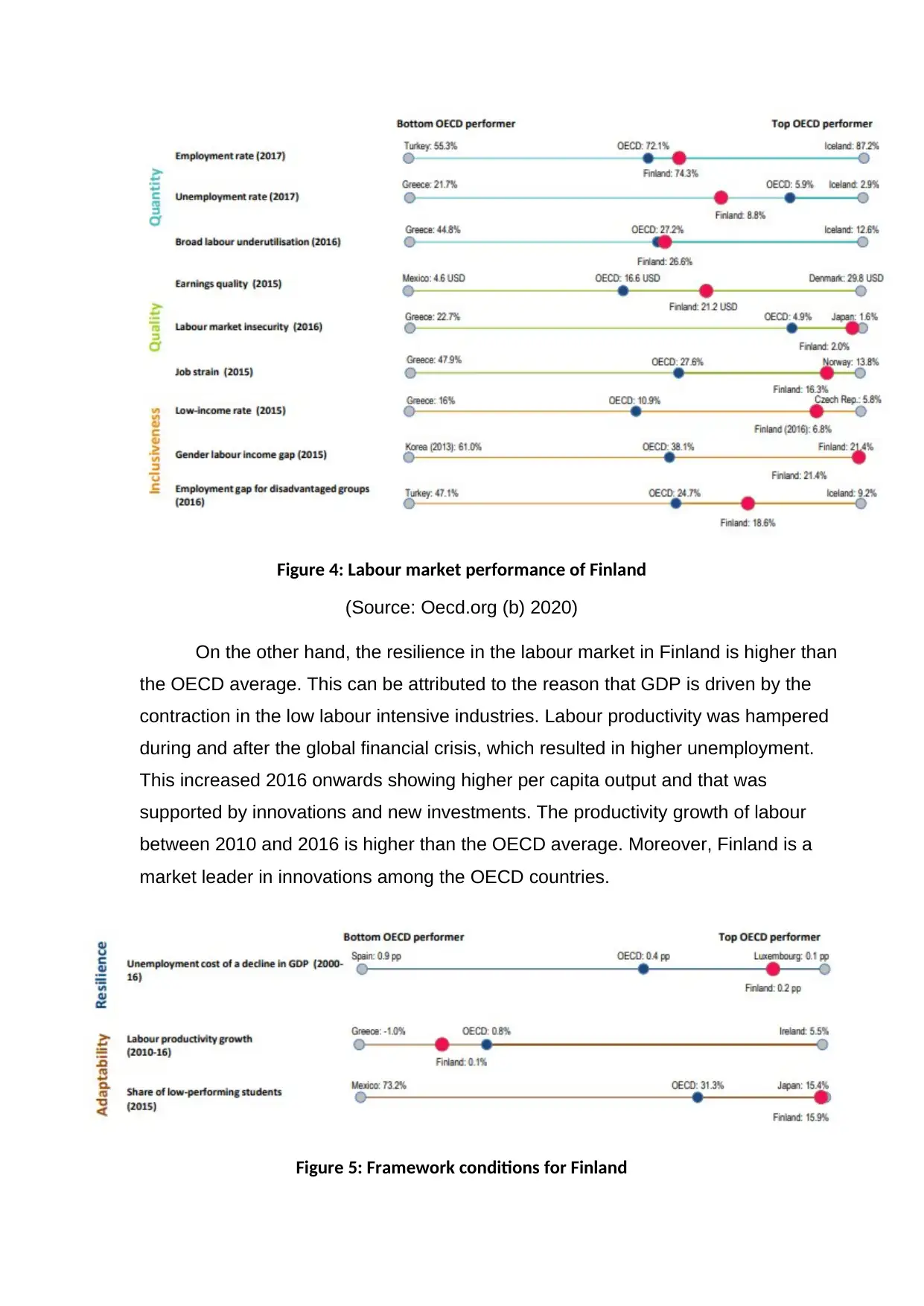
Figure 4: Labour market performance of Finland
(Source: Oecd.org (b) 2020)
On the other hand, the resilience in the labour market in Finland is higher than
the OECD average. This can be attributed to the reason that GDP is driven by the
contraction in the low labour intensive industries. Labour productivity was hampered
during and after the global financial crisis, which resulted in higher unemployment.
This increased 2016 onwards showing higher per capita output and that was
supported by innovations and new investments. The productivity growth of labour
between 2010 and 2016 is higher than the OECD average. Moreover, Finland is a
market leader in innovations among the OECD countries.
Figure 5: Framework conditions for Finland
(Source: Oecd.org (b) 2020)
On the other hand, the resilience in the labour market in Finland is higher than
the OECD average. This can be attributed to the reason that GDP is driven by the
contraction in the low labour intensive industries. Labour productivity was hampered
during and after the global financial crisis, which resulted in higher unemployment.
This increased 2016 onwards showing higher per capita output and that was
supported by innovations and new investments. The productivity growth of labour
between 2010 and 2016 is higher than the OECD average. Moreover, Finland is a
market leader in innovations among the OECD countries.
Figure 5: Framework conditions for Finland
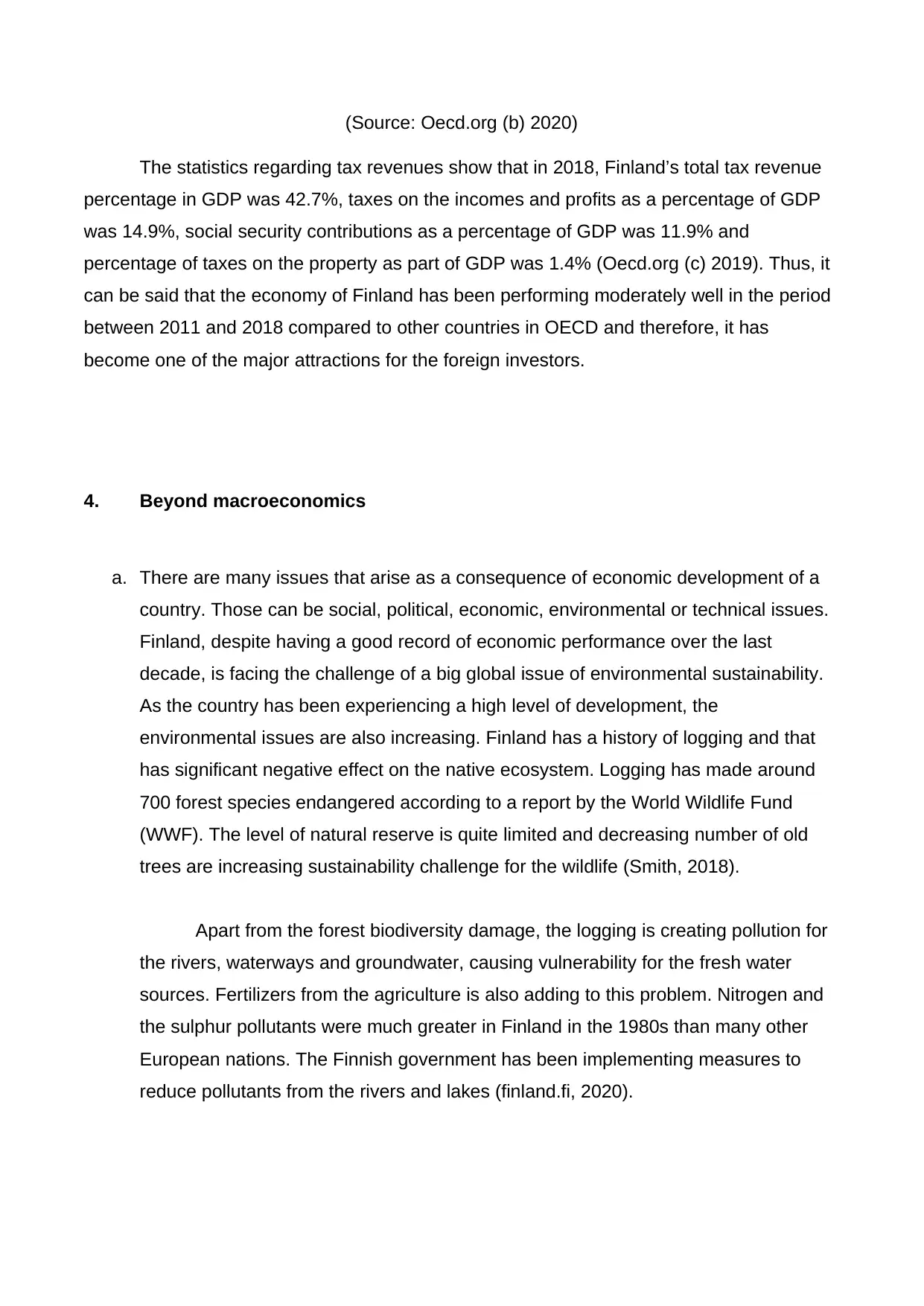
(Source: Oecd.org (b) 2020)
The statistics regarding tax revenues show that in 2018, Finland’s total tax revenue
percentage in GDP was 42.7%, taxes on the incomes and profits as a percentage of GDP
was 14.9%, social security contributions as a percentage of GDP was 11.9% and
percentage of taxes on the property as part of GDP was 1.4% (Oecd.org (c) 2019). Thus, it
can be said that the economy of Finland has been performing moderately well in the period
between 2011 and 2018 compared to other countries in OECD and therefore, it has
become one of the major attractions for the foreign investors.
4. Beyond macroeconomics
a. There are many issues that arise as a consequence of economic development of a
country. Those can be social, political, economic, environmental or technical issues.
Finland, despite having a good record of economic performance over the last
decade, is facing the challenge of a big global issue of environmental sustainability.
As the country has been experiencing a high level of development, the
environmental issues are also increasing. Finland has a history of logging and that
has significant negative effect on the native ecosystem. Logging has made around
700 forest species endangered according to a report by the World Wildlife Fund
(WWF). The level of natural reserve is quite limited and decreasing number of old
trees are increasing sustainability challenge for the wildlife (Smith, 2018).
Apart from the forest biodiversity damage, the logging is creating pollution for
the rivers, waterways and groundwater, causing vulnerability for the fresh water
sources. Fertilizers from the agriculture is also adding to this problem. Nitrogen and
the sulphur pollutants were much greater in Finland in the 1980s than many other
European nations. The Finnish government has been implementing measures to
reduce pollutants from the rivers and lakes (finland.fi, 2020).
The statistics regarding tax revenues show that in 2018, Finland’s total tax revenue
percentage in GDP was 42.7%, taxes on the incomes and profits as a percentage of GDP
was 14.9%, social security contributions as a percentage of GDP was 11.9% and
percentage of taxes on the property as part of GDP was 1.4% (Oecd.org (c) 2019). Thus, it
can be said that the economy of Finland has been performing moderately well in the period
between 2011 and 2018 compared to other countries in OECD and therefore, it has
become one of the major attractions for the foreign investors.
4. Beyond macroeconomics
a. There are many issues that arise as a consequence of economic development of a
country. Those can be social, political, economic, environmental or technical issues.
Finland, despite having a good record of economic performance over the last
decade, is facing the challenge of a big global issue of environmental sustainability.
As the country has been experiencing a high level of development, the
environmental issues are also increasing. Finland has a history of logging and that
has significant negative effect on the native ecosystem. Logging has made around
700 forest species endangered according to a report by the World Wildlife Fund
(WWF). The level of natural reserve is quite limited and decreasing number of old
trees are increasing sustainability challenge for the wildlife (Smith, 2018).
Apart from the forest biodiversity damage, the logging is creating pollution for
the rivers, waterways and groundwater, causing vulnerability for the fresh water
sources. Fertilizers from the agriculture is also adding to this problem. Nitrogen and
the sulphur pollutants were much greater in Finland in the 1980s than many other
European nations. The Finnish government has been implementing measures to
reduce pollutants from the rivers and lakes (finland.fi, 2020).
⊘ This is a preview!⊘
Do you want full access?
Subscribe today to unlock all pages.

Trusted by 1+ million students worldwide
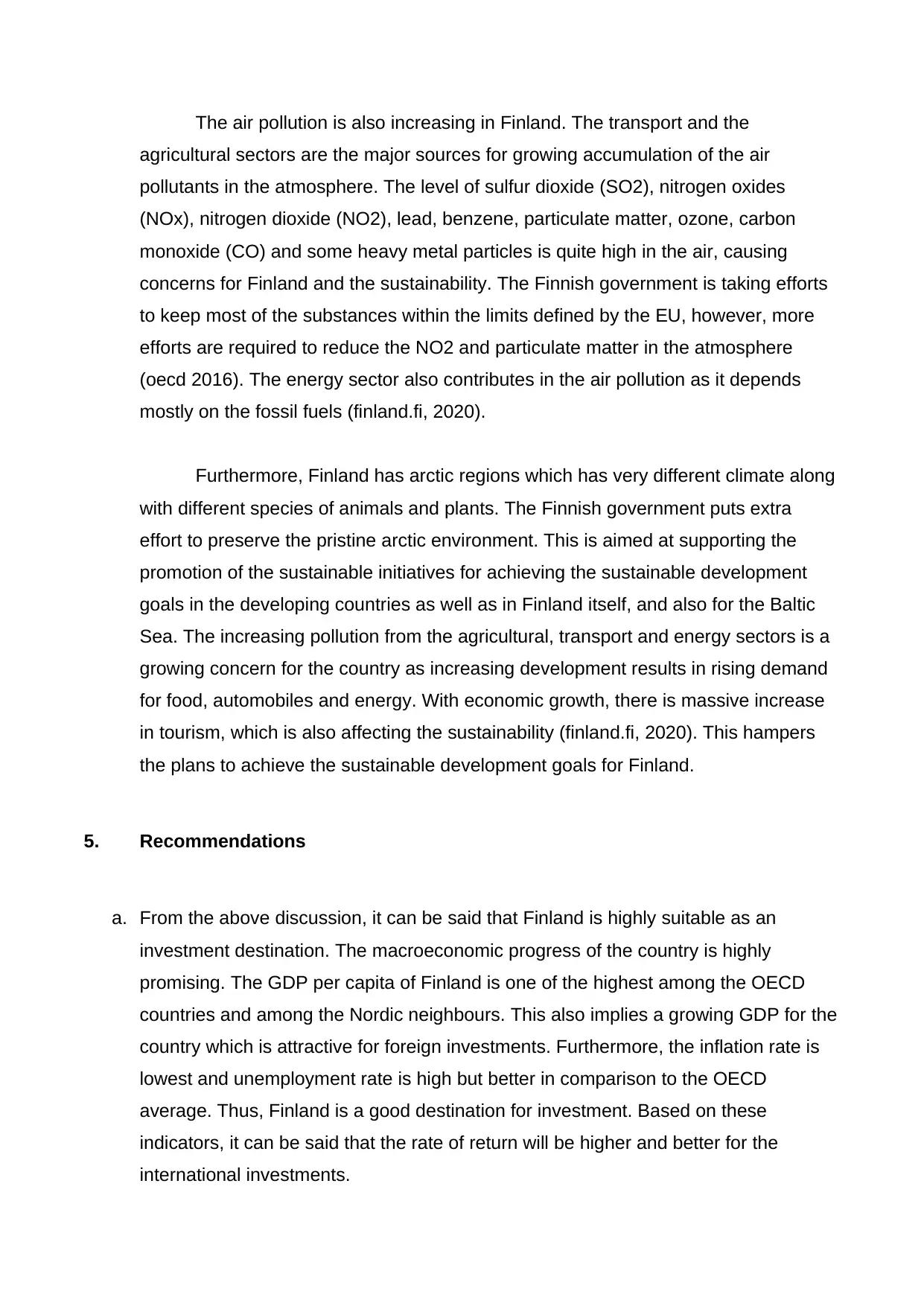
The air pollution is also increasing in Finland. The transport and the
agricultural sectors are the major sources for growing accumulation of the air
pollutants in the atmosphere. The level of sulfur dioxide (SO2), nitrogen oxides
(NOx), nitrogen dioxide (NO2), lead, benzene, particulate matter, ozone, carbon
monoxide (CO) and some heavy metal particles is quite high in the air, causing
concerns for Finland and the sustainability. The Finnish government is taking efforts
to keep most of the substances within the limits defined by the EU, however, more
efforts are required to reduce the NO2 and particulate matter in the atmosphere
(oecd 2016). The energy sector also contributes in the air pollution as it depends
mostly on the fossil fuels (finland.fi, 2020).
Furthermore, Finland has arctic regions which has very different climate along
with different species of animals and plants. The Finnish government puts extra
effort to preserve the pristine arctic environment. This is aimed at supporting the
promotion of the sustainable initiatives for achieving the sustainable development
goals in the developing countries as well as in Finland itself, and also for the Baltic
Sea. The increasing pollution from the agricultural, transport and energy sectors is a
growing concern for the country as increasing development results in rising demand
for food, automobiles and energy. With economic growth, there is massive increase
in tourism, which is also affecting the sustainability (finland.fi, 2020). This hampers
the plans to achieve the sustainable development goals for Finland.
5. Recommendations
a. From the above discussion, it can be said that Finland is highly suitable as an
investment destination. The macroeconomic progress of the country is highly
promising. The GDP per capita of Finland is one of the highest among the OECD
countries and among the Nordic neighbours. This also implies a growing GDP for the
country which is attractive for foreign investments. Furthermore, the inflation rate is
lowest and unemployment rate is high but better in comparison to the OECD
average. Thus, Finland is a good destination for investment. Based on these
indicators, it can be said that the rate of return will be higher and better for the
international investments.
agricultural sectors are the major sources for growing accumulation of the air
pollutants in the atmosphere. The level of sulfur dioxide (SO2), nitrogen oxides
(NOx), nitrogen dioxide (NO2), lead, benzene, particulate matter, ozone, carbon
monoxide (CO) and some heavy metal particles is quite high in the air, causing
concerns for Finland and the sustainability. The Finnish government is taking efforts
to keep most of the substances within the limits defined by the EU, however, more
efforts are required to reduce the NO2 and particulate matter in the atmosphere
(oecd 2016). The energy sector also contributes in the air pollution as it depends
mostly on the fossil fuels (finland.fi, 2020).
Furthermore, Finland has arctic regions which has very different climate along
with different species of animals and plants. The Finnish government puts extra
effort to preserve the pristine arctic environment. This is aimed at supporting the
promotion of the sustainable initiatives for achieving the sustainable development
goals in the developing countries as well as in Finland itself, and also for the Baltic
Sea. The increasing pollution from the agricultural, transport and energy sectors is a
growing concern for the country as increasing development results in rising demand
for food, automobiles and energy. With economic growth, there is massive increase
in tourism, which is also affecting the sustainability (finland.fi, 2020). This hampers
the plans to achieve the sustainable development goals for Finland.
5. Recommendations
a. From the above discussion, it can be said that Finland is highly suitable as an
investment destination. The macroeconomic progress of the country is highly
promising. The GDP per capita of Finland is one of the highest among the OECD
countries and among the Nordic neighbours. This also implies a growing GDP for the
country which is attractive for foreign investments. Furthermore, the inflation rate is
lowest and unemployment rate is high but better in comparison to the OECD
average. Thus, Finland is a good destination for investment. Based on these
indicators, it can be said that the rate of return will be higher and better for the
international investments.
Paraphrase This Document
Need a fresh take? Get an instant paraphrase of this document with our AI Paraphraser
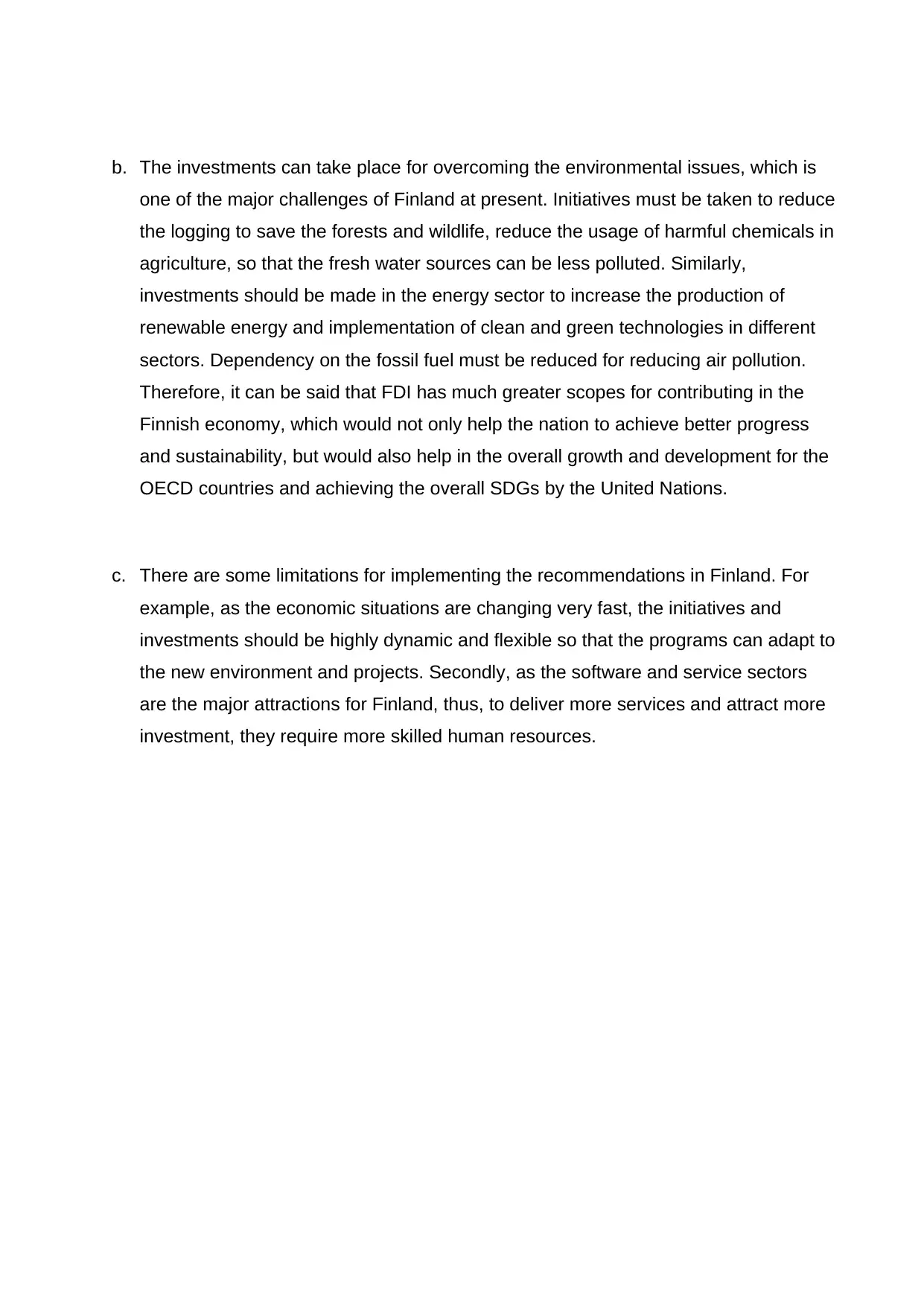
b. The investments can take place for overcoming the environmental issues, which is
one of the major challenges of Finland at present. Initiatives must be taken to reduce
the logging to save the forests and wildlife, reduce the usage of harmful chemicals in
agriculture, so that the fresh water sources can be less polluted. Similarly,
investments should be made in the energy sector to increase the production of
renewable energy and implementation of clean and green technologies in different
sectors. Dependency on the fossil fuel must be reduced for reducing air pollution.
Therefore, it can be said that FDI has much greater scopes for contributing in the
Finnish economy, which would not only help the nation to achieve better progress
and sustainability, but would also help in the overall growth and development for the
OECD countries and achieving the overall SDGs by the United Nations.
c. There are some limitations for implementing the recommendations in Finland. For
example, as the economic situations are changing very fast, the initiatives and
investments should be highly dynamic and flexible so that the programs can adapt to
the new environment and projects. Secondly, as the software and service sectors
are the major attractions for Finland, thus, to deliver more services and attract more
investment, they require more skilled human resources.
one of the major challenges of Finland at present. Initiatives must be taken to reduce
the logging to save the forests and wildlife, reduce the usage of harmful chemicals in
agriculture, so that the fresh water sources can be less polluted. Similarly,
investments should be made in the energy sector to increase the production of
renewable energy and implementation of clean and green technologies in different
sectors. Dependency on the fossil fuel must be reduced for reducing air pollution.
Therefore, it can be said that FDI has much greater scopes for contributing in the
Finnish economy, which would not only help the nation to achieve better progress
and sustainability, but would also help in the overall growth and development for the
OECD countries and achieving the overall SDGs by the United Nations.
c. There are some limitations for implementing the recommendations in Finland. For
example, as the economic situations are changing very fast, the initiatives and
investments should be highly dynamic and flexible so that the programs can adapt to
the new environment and projects. Secondly, as the software and service sectors
are the major attractions for Finland, thus, to deliver more services and attract more
investment, they require more skilled human resources.
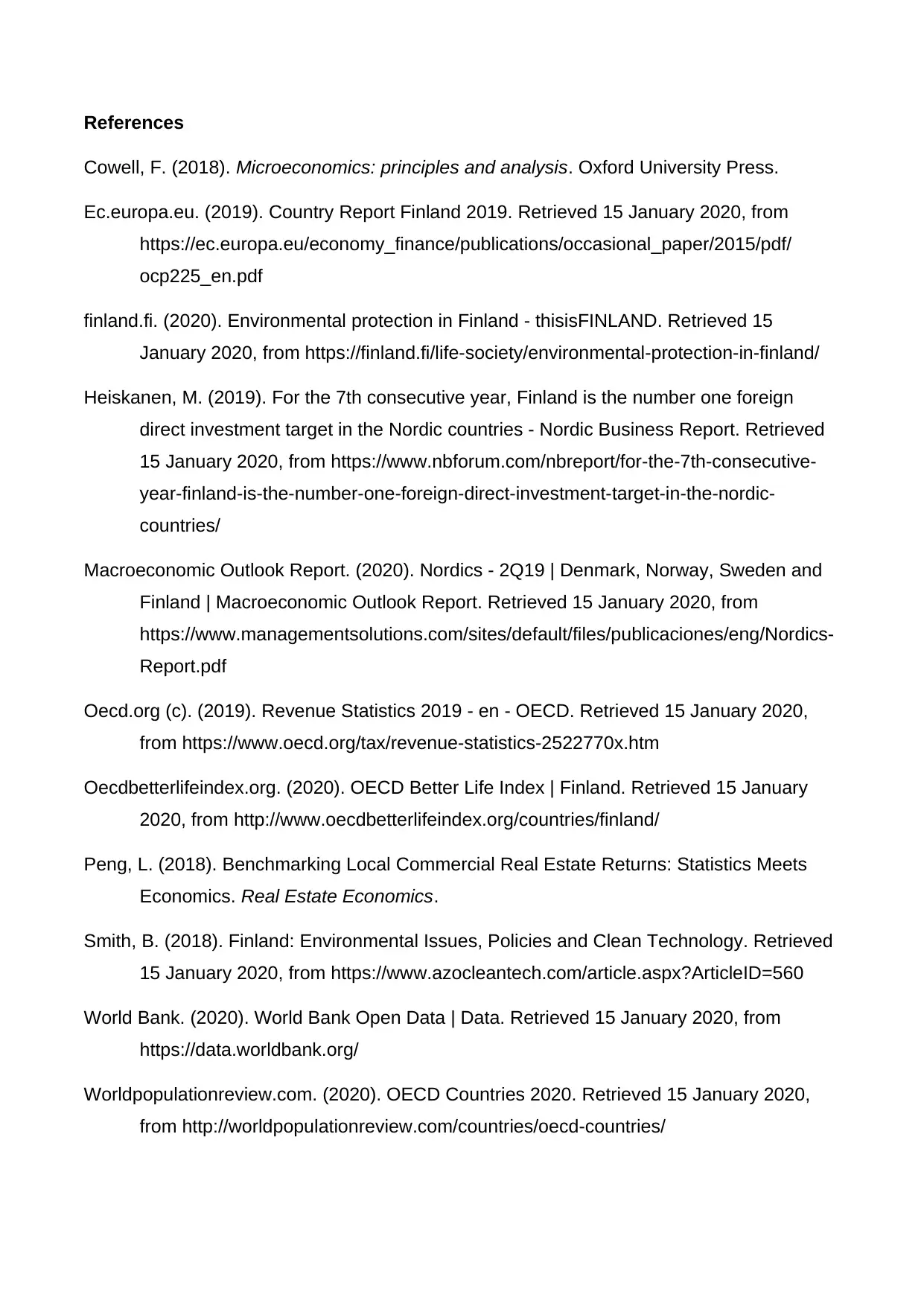
References
Cowell, F. (2018). Microeconomics: principles and analysis. Oxford University Press.
Ec.europa.eu. (2019). Country Report Finland 2019. Retrieved 15 January 2020, from
https://ec.europa.eu/economy_finance/publications/occasional_paper/2015/pdf/
ocp225_en.pdf
finland.fi. (2020). Environmental protection in Finland - thisisFINLAND. Retrieved 15
January 2020, from https://finland.fi/life-society/environmental-protection-in-finland/
Heiskanen, M. (2019). For the 7th consecutive year, Finland is the number one foreign
direct investment target in the Nordic countries - Nordic Business Report. Retrieved
15 January 2020, from https://www.nbforum.com/nbreport/for-the-7th-consecutive-
year-finland-is-the-number-one-foreign-direct-investment-target-in-the-nordic-
countries/
Macroeconomic Outlook Report. (2020). Nordics - 2Q19 | Denmark, Norway, Sweden and
Finland | Macroeconomic Outlook Report. Retrieved 15 January 2020, from
https://www.managementsolutions.com/sites/default/files/publicaciones/eng/Nordics-
Report.pdf
Oecd.org (c). (2019). Revenue Statistics 2019 - en - OECD. Retrieved 15 January 2020,
from https://www.oecd.org/tax/revenue-statistics-2522770x.htm
Oecdbetterlifeindex.org. (2020). OECD Better Life Index | Finland. Retrieved 15 January
2020, from http://www.oecdbetterlifeindex.org/countries/finland/
Peng, L. (2018). Benchmarking Local Commercial Real Estate Returns: Statistics Meets
Economics. Real Estate Economics.
Smith, B. (2018). Finland: Environmental Issues, Policies and Clean Technology. Retrieved
15 January 2020, from https://www.azocleantech.com/article.aspx?ArticleID=560
World Bank. (2020). World Bank Open Data | Data. Retrieved 15 January 2020, from
https://data.worldbank.org/
Worldpopulationreview.com. (2020). OECD Countries 2020. Retrieved 15 January 2020,
from http://worldpopulationreview.com/countries/oecd-countries/
Cowell, F. (2018). Microeconomics: principles and analysis. Oxford University Press.
Ec.europa.eu. (2019). Country Report Finland 2019. Retrieved 15 January 2020, from
https://ec.europa.eu/economy_finance/publications/occasional_paper/2015/pdf/
ocp225_en.pdf
finland.fi. (2020). Environmental protection in Finland - thisisFINLAND. Retrieved 15
January 2020, from https://finland.fi/life-society/environmental-protection-in-finland/
Heiskanen, M. (2019). For the 7th consecutive year, Finland is the number one foreign
direct investment target in the Nordic countries - Nordic Business Report. Retrieved
15 January 2020, from https://www.nbforum.com/nbreport/for-the-7th-consecutive-
year-finland-is-the-number-one-foreign-direct-investment-target-in-the-nordic-
countries/
Macroeconomic Outlook Report. (2020). Nordics - 2Q19 | Denmark, Norway, Sweden and
Finland | Macroeconomic Outlook Report. Retrieved 15 January 2020, from
https://www.managementsolutions.com/sites/default/files/publicaciones/eng/Nordics-
Report.pdf
Oecd.org (c). (2019). Revenue Statistics 2019 - en - OECD. Retrieved 15 January 2020,
from https://www.oecd.org/tax/revenue-statistics-2522770x.htm
Oecdbetterlifeindex.org. (2020). OECD Better Life Index | Finland. Retrieved 15 January
2020, from http://www.oecdbetterlifeindex.org/countries/finland/
Peng, L. (2018). Benchmarking Local Commercial Real Estate Returns: Statistics Meets
Economics. Real Estate Economics.
Smith, B. (2018). Finland: Environmental Issues, Policies and Clean Technology. Retrieved
15 January 2020, from https://www.azocleantech.com/article.aspx?ArticleID=560
World Bank. (2020). World Bank Open Data | Data. Retrieved 15 January 2020, from
https://data.worldbank.org/
Worldpopulationreview.com. (2020). OECD Countries 2020. Retrieved 15 January 2020,
from http://worldpopulationreview.com/countries/oecd-countries/
⊘ This is a preview!⊘
Do you want full access?
Subscribe today to unlock all pages.

Trusted by 1+ million students worldwide
1 out of 13
Related Documents
Your All-in-One AI-Powered Toolkit for Academic Success.
+13062052269
info@desklib.com
Available 24*7 on WhatsApp / Email
![[object Object]](/_next/static/media/star-bottom.7253800d.svg)
Unlock your academic potential
Copyright © 2020–2025 A2Z Services. All Rights Reserved. Developed and managed by ZUCOL.




